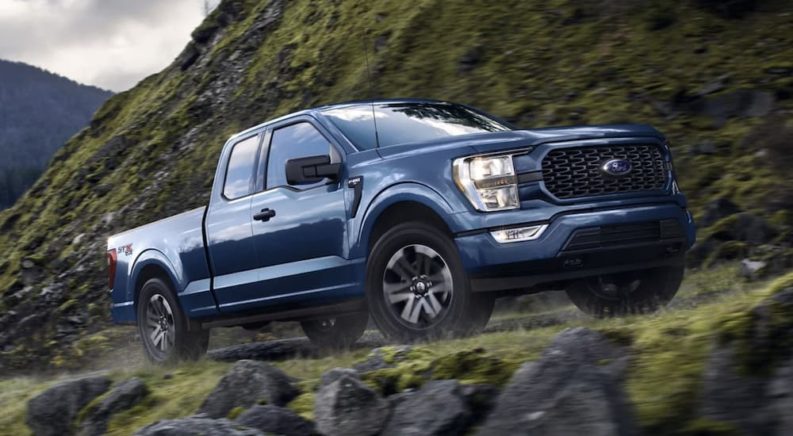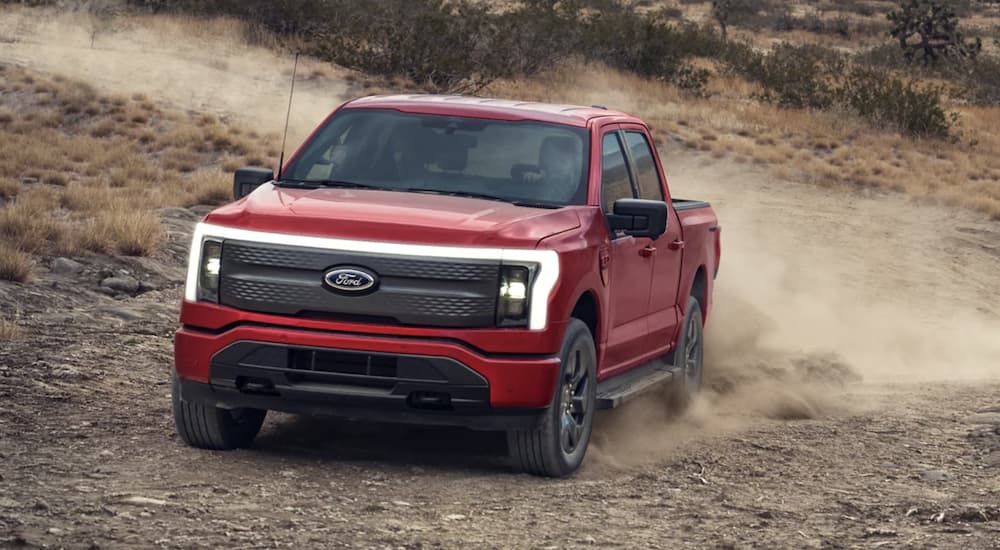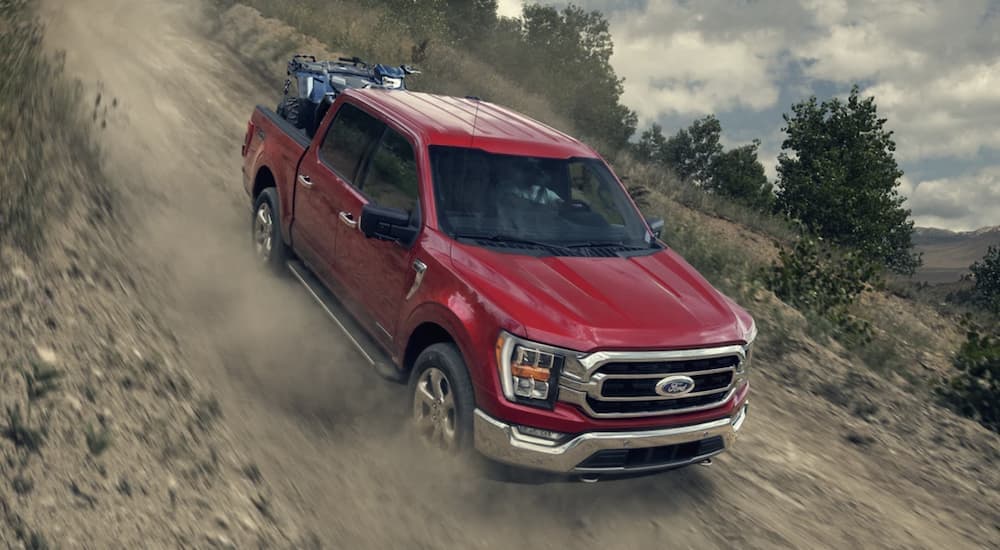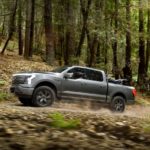With the introduction of the all-new, all-electric Ford F-150 Lightning, a lot of attention is being paid to this exciting evolution of Ford’s best-selling pickup. There are plenty of good reasons for this, too, not the least of which is that a new focus on electric trucks will be a vital part of car companies shifting to all-electric lineups. With all of this focus on the new Lightning, you might be wondering if the 2023 Ford F-150, with its conventional gas-powered engines, has anything going for it or if it’s purely a relic of a bygone era.
Honestly, there’s a lot to like about the F-150 Lightning, and I think it’s a fantastic first step toward trucks finding their place in the growing Battery-Electric Vehicle (BEV) market in the auto industry. That being said, it’s not an absolutely perfect vehicle that’s going to immediately turn the standard F-150 into a dinosaur. Beyond the uncertainty that some people have about switching to a BEV model, there are also some other good reasons that a lot of folks are going to stick with the classic F-150 for a while. Let’s take a look at some of them.
The Engine Options
When it comes to the engines on these trucks, things get a bit complicated. To be fair, the powertrains available on the F-150 Lighting are definitely impressive: it starts with 452 hp, and there’s a more powerful version that kicks that up to 580 hp, and both have 775 lb-ft of torque. Honestly, that’s more power than any of the conventional gas engines on the standard F-150, plus any traditional engine can’t beat the instant torque of a BEV motor system, so the power of this thing is definitely something to behold.
That being said, it’s worth noting that the conventional F-150 model gives you a lot more engine options to choose from. Rather than two possible powertrains, there are five engines available on the F-150, including numerous V6 options, a V8, and even a PowerBoost Turbo hybrid engine. This hybrid is arguably the best overall choice with 430 hp and 570 lb-ft of torque plus fantastic towing and payload capacities (more on that in a moment), but it still falls short of what the Lightning can do. So while the Lightning wins in terms of raw numbers, the greater choice of options can be a big draw for some truck buyers. Plus, you know what to expect from a gas engine, while BEV power systems are still unknown to many of us.
Towing and Payload
While that first point was certainly a mixed bag, this is a reason to go with the conventional Ford F-150 over the impressive new Lightning. Although Ford’s engineers have managed to deliver respectable towing and payload with the Lightning, they still haven’t figured out how to make it as capable as their gas-powered beauty. The standard Lightning model can haul up to 7,700 lbs behind it and has a maximum payload of 2,000 lbs; going with the upgraded power system boosts towing to 10,000 lbs but cuts payload down to 1,850 lbs due to the extra weight of the extended range batteries.
With five different engines available, the capability for the traditional F-150 can vary quite a lot, but it pretty well mops the floor with the Lightning across the board. The starting engine on the F-150 gives it 8,200 lbs of towing capacity and 1,985 lbs of payload – just slightly under the maximum payload on the standard Lightning model. More powerful engines can significantly increase this capability, however, topping out with the available 3.5L EcoBoost Turbo V6 engine can tow up to 14,000 lbs and still has 3,250 lbs of payload capacity.
For a slightly greater payload, the available V8 engine tops out at 3,325 lbs though it can only handle up to 13,000 lbs of towing. Even if you go with the available hybrid engine for the conventional F-150, it still tops out at 12,700 lbs of towing capacity and 2,120 lbs of payload. It’s impressive that Ford managed to reach 10,000 lbs of towing with the Lightning, but anyone looking for more than that will certainly want to go with the tried and true F-150.
The Cargo Space
Handling a lot of weight is important, but just as important is having plenty of bed space to load up with everything you need to take with you. This is another area where the Lightning falls short, at least for the time being. There’s only one bed option for the Lightning model: a 5.5-foot bed that allows for 52.8 cu.ft. of cargo capacity, though the front truck does provide another 14.1 cu.ft. of storage. This is 66.9 cu.ft. of total cargo volume, which is great, but being split between the bed and a frunk is not going to work for everyone.
The traditional F-150 has three bed lengths available, with the 5.5-foot option as the smallest one you can choose. There’s a 6.5-foot bed that provides 62.3 cu.ft. of cargo capacity – slightly less than the total cargo space with the Lightning, but it’s not split between the bed and trunk – along with an 8-foot bed that has 77.4 cu.ft. of cargo space. I assume the lack of longer beds is a concession for the BEV truck to maximize its range and capabilities, but it’s a shame to see such a limitation on a full-size pickup.
Range From a Full Tank/Charge
It’s difficult to directly compare things like fuel economy and electric range since there are some big differences between them, but they’re important to consider. Assuming you’re in a situation where you can easily charge at home or have access to DC public charging stations nearby, it’s quite simple to keep the Lightning charged. The Standard Range model can go up to 240 miles from a full charge, while the Extended Range can go an estimated 320 miles.
In terms of traditional fuel economy, the impressive V6 hybrid engine on the conventional Ford F-150 is the way to go as it gets an estimated 25 MPG in the city and on the highway with rear-wheel drive. Going with a four-wheel drive model cuts that down slightly to an estimated 23 MPG in the city and on the highway. The EPA has not released an estimate for the maximum range with this engine, but looking at the standard 3.3L V6 engine, they estimate between 502 and 567 miles of range from a full tank. That certainly blows away what the Lightning can do, and the hybrid engine will likely outperform that.
The Price
If money’s no object to you, then the price of your truck might not be how you decide on which model you go with, but for me, it’s definitely important. The starting MSRP on the standard 2023 Ford F-150 is $33,695, while the Lightning starts at $55,974. That’s a pretty huge difference, and moving up trims or choosing the available Extended Range model can greatly increase the cost of the Lightning. While the F-150 can also get more expensive at higher trims or with more powerful engines, the Lightning will likely cost you more. Some buyers can qualify for a $7,500 tax credit for buying the Lighting, but there are quite a few stipulations on that, and they have to earn enough each year to get the full benefit of that credit.
What’s the Future for the F-150?
Like other car companies, Ford plans to move toward an all-electric lineup over the next decade or so. At the moment, it’s pretty clear they need to overcome some hurdles to eventually justify eliminating the gas-powered F-150 and only offering the Lightning to their customers. They have plenty of time for this, so I’m not too worried about it; as it stands right now, however, there are quite a few reasons for people to choose the conventional F-150 over the new and shiny Lightning.






